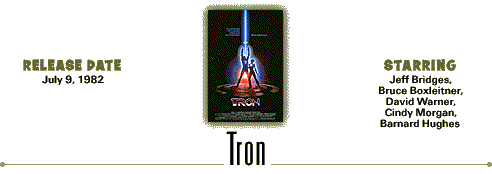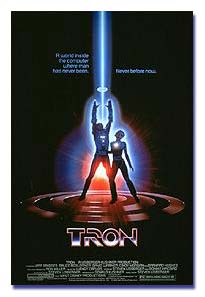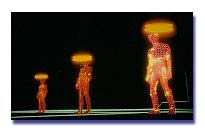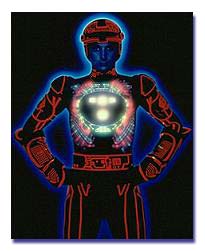 |
 |
 |
 lynn, a young computer genius, breaks into the ENCOM
computer looking for evidence that the video game programs he wrote
were stolen by Dillinger, an ENCOM executive. Dillinger's Master
Control Program must stop Flynn, and it blasts him into its own
computer dimension. Flynn awakens in an electronic world, where
computer programs are the alter-egos of the programmers who created
them, and he is sentenced to die on the video game grid. Together
with Tron, an electronic security program, Flynn escapes and
destroys the MCP, and is able to return to the "real" world. lynn, a young computer genius, breaks into the ENCOM
computer looking for evidence that the video game programs he wrote
were stolen by Dillinger, an ENCOM executive. Dillinger's Master
Control Program must stop Flynn, and it blasts him into its own
computer dimension. Flynn awakens in an electronic world, where
computer programs are the alter-egos of the programmers who created
them, and he is sentenced to die on the video game grid. Together
with Tron, an electronic security program, Flynn escapes and
destroys the MCP, and is able to return to the "real" world. |
|
 |

Out of director Steven Lisberger's passion for computer games grew
the idea for "Tron." He and producer Donald Kushner spent two years
researching the technology to make the film, with which he made his
live-action directorial debut. The film was the first motion
picture to make extensive use of computer imagery, requiring much
expertise and imagination. Though computer imagery had been
previously seen as an effect in motion pictures such as "Star Wars"
and "West World," "Tron" was the first film to use the technique to
create a three-dimensional world. The special effects team was
headed by futuristic industrial designer Syd Mead, comic artist
"Moebius" Giraud, and high-tech commercial artist Peter Lloyd.
Harrison Ellenshaw supervised the effects with Richard Taylor.
Computer graphics were first applied to aerospace and scientific
research in the mid-1960s, when methods of simulating objects
digitally proved as effective as building models. The technology
was then diverted into the entertainment field. Information
International Inc. (Triple-I) and Robert Able & Associates of
Los Angeles, and the Mathematic Applications Group Inc. (MAGI) and
Digital Effects of New York, produced the computer imagery for the
film. MAGI, the single largest contributor of computer imagery,
speeded up the process of supplying its work to Disney Studios in
Burbank via a transcontinental computer hook-up. The computer link
cut between two and a half and five days from the creation of each
scene. The electronic world was shot on sound stages at the Disney
Studio in Burbank. Photography for the real world took place at
locations around Los Angeles and at the U.S. Government's
futuristic Lawrence Livermore Laboratory outside Oakland,
California. The film was not the box office bonanza the Studio had
hoped for, but it did spawn a number of popular video games. |
|
 |

Directed by Steven Lisberger. 96 min. Photographed in Super
Panavision 70mm. "Tron" was nominated for Academy Awards® for
Sound by Michael, Bob, and Lee Minkler and Jim La Rue, and Costume
Design by Elois Jenssen and Rosanna Norton. Released on video in
1982 and 1993. |
|
 |
 |
|
|
 |
 |
 |
|
|
 |
|
 |